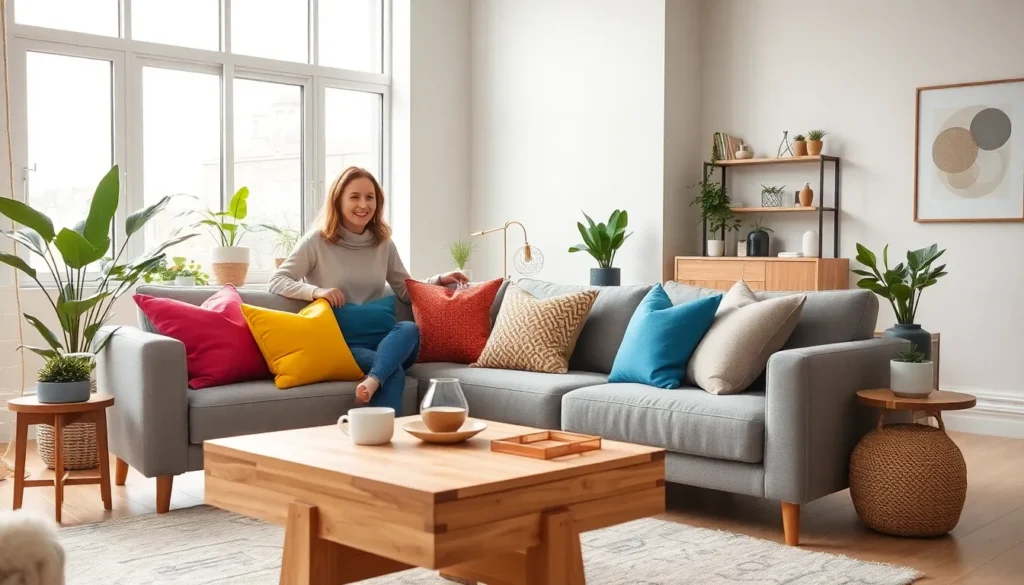Architectural design concepts are the secret sauce behind every stunning building, from cozy homes to towering skyscrapers. They’re not just about aesthetics; they shape how people interact with spaces and each other. Imagine walking into a room that feels just right—it’s like a hug from architecture!
Table of Contents
ToggleOverview of Architectural Design Concepts
Architectural design concepts encompass a wide array of principles guiding the creation of functional and aesthetically pleasing spaces. These principles influence space utilization, environmental interaction, and emotional resonance. Form follows function remains a foundational concept, emphasizing that a building’s design must serve its intended purpose while remaining visually appealing.
Sustainability plays a crucial role in contemporary architecture. Architects integrate eco-friendly materials and energy-efficient systems, aiming to reduce a building’s carbon footprint. Innovative concepts like biophilic design enhance the connection between indoor environments and nature, fostering well-being.
Modularity is another significant trend in architectural design. By employing prefabricated components, projects can achieve faster construction times and reduced waste. This approach enhances design flexibility, allowing architects to adapt spaces to meet evolving needs.
Cultural context shapes architectural expressions. Local traditions and materials influence design choices, creating structures that reflect community identity. Understanding the surrounding environment helps architects create buildings that harmonize with their settings.
Universal design principles promote accessibility for individuals with diverse needs. Ensuring spaces accommodate everyone enables inclusive environments, enhancing overall user experience. Architects consider aspects like layout, signage, and materials to achieve this goal.
Innovation in technology also transforms architectural design. Tools like Building Information Modeling (BIM) enhance collaboration among teams, streamline workflows, and improve accuracy in planning. Additionally, virtual reality applications allow for immersive design experiences, enabling clients to visualize spaces before construction begins.
Architectural design concepts are integral to shaping functional, sustainable, and culturally relevant environments. Each principle contributes to the emotional and social impacts of the spaces where people live, work, and interact.
Key Elements of Architectural Design

Architectural design comprises critical elements that shape buildings and spaces. Understanding these elements enhances the overall quality and functionality of structures.
Form and Space
Form encompasses the physical shape of a structure, while space refers to how individuals interact within it. Enveloping spaces through walls, ceilings, and openings establish ambiance. Each design element influences movement and flow, allowing users to engage with their environment. Architects often consider the relationship between form and space, ensuring that structures are both functional and inviting. Implementing various scales and proportions contributes to the overall user experience, making each space feel unique and fulfilling.
Functionality
Functionality serves as the backbone of effective architectural design. This principle asserts that every design choice must address specific needs and activities. Buildings should facilitate daily tasks while promoting efficiency. By prioritizing the intended use, architects create layouts that enhance user experiences. For instance, an office space might incorporate collaborative zones alongside private work areas, supporting varied functionalities. Overall, thoughtful design optimizes how users interact with their surroundings, ensuring that form resonates with purpose.
Aesthetics
Aesthetics play a crucial role in architectural design, impacting emotional responses and human connection. Elements like color, texture, and materials significantly enhance visual appeal. Creating harmonious and balanced designs fosters a sense of beauty and tranquility. Accents such as windows and doors provide not just functionality but also contribute architecturally to the overall aesthetic. By blending artistic vision with practical elements, architects evoke emotional connections and elevate spaces to a more profound experience. Each aesthetic choice ultimately reflects the culture and context, enriching the built environment.
Types of Architectural Design Concepts
Architectural design concepts encompass various styles and approaches, reflecting cultural values and technological advancements. Each type serves distinct purposes while shaping user experiences.
Traditional Design
Traditional design refers to architectural styles rooted in history and cultural heritage. Historical influences manifest through classic styles like Colonial, Gothic, and Victorian. Elements such as symmetry and decorative details often characterize these buildings. Architects prioritize materials like wood, stone, and brick, connecting structures to their environment. Traditional designs create a sense of familiarity and continuity, fostering a connection to community history.
Modern Design
Modern design emphasizes minimalism and functionality, moving away from elaborate ornamentation found in traditional styles. This approach highlights clean lines, open spaces, and the use of innovative materials like glass and steel. Architects focus on efficient layouts that promote natural light and ventilation. Concepts like open floor plans encourage social interaction and adaptability among spaces. Notable examples include the works of architects such as Le Corbusier and Ludwig Mies van der Rohe, showcasing simplicity merged with elegance.
Sustainable Design
Sustainable design prioritizes environmental responsibility and resource efficiency. Architects integrate eco-friendly materials, energy-efficient systems, and renewable energy sources in these projects. Strategies include designing for optimal energy use, incorporating green roofs, and utilizing passive heating and cooling methods. This approach fosters an ecological balance while enhancing occupants’ well-being. Notable sustainable structures, such as the Bullitt Center in Seattle, exemplify how thoughtful design can reduce carbon footprints and promote sustainability.
Influences on Architectural Design Concepts
Cultural and technological forces significantly shape architectural design concepts. Understanding these influences helps architects create spaces that resonate with communities and harness innovative tools for improved functionality.
Cultural Factors
Cultural factors profoundly impact architectural design. Design elements often reflect a region’s history, values, and traditions. Regional styles incorporate local materials and environmental considerations, fostering a sense of identity. Historical references, such as traditional motifs or indigenous structures, serve to connect modern buildings with their cultural context. Community-driven designs emphasize inclusivity and respond to the unique needs of diverse populations. Cultural heritage and contemporary practices blend, resulting in architecture that tells a story while serving functional purposes. Architects often collaborate with local communities, ensuring that designs honor traditions while accommodating modern lifestyles.
Technological Advances
Technological advances revolutionize architectural design concepts. The emergence of Building Information Modeling (BIM) enhances precision and collaboration among stakeholders. Architects use virtual reality tools to present designs to clients, allowing for immersive experiences before construction begins. Drones and 3D printing streamline surveying and prototyping, reducing time and material waste. Smart technologies are increasingly integrated into building systems, improving energy efficiency and user comfort. Sustainable innovations also play a role, with architects utilizing cutting-edge materials to enhance environmental performance. These advances not only transform how architects approach projects but also improve overall user experiences in modern built environments.
Architectural design concepts play a pivotal role in shaping the environments where people live and work. By focusing on functionality aesthetics and sustainability architects create spaces that resonate emotionally with users. The integration of cultural context and technological advancements ensures that designs are not only innovative but also relevant to the communities they serve.
As the field continues to evolve embracing new ideas and practices will be essential for meeting the diverse needs of society. Ultimately architectural design concepts are more than just blueprints; they represent a commitment to enhancing the human experience through thoughtful and impactful design.









